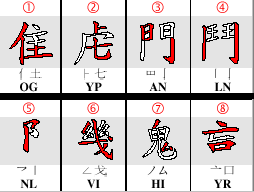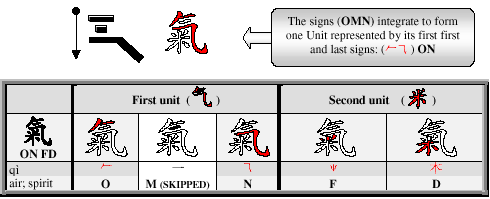The purpose of the four exception is to simply the input process by either reducing the number of codes representing a character or by simplifying the breakdown of its shapes and the spotting of of the signs inside the characters.
- Exception 1: Eight characters shapes are exceptionably grouped and represented by 2 codes only:

The 8 character shapes & their condensed code :
Example:
=
instead of YROYG
- Exception 2: Virtual integration to form a unit is automatically applied to 11 character shapes when they are located in a first unit position or second unit position of three unit character. (They follow the normal rules when they are in other position, i.e. : the second (last position in two unit characters and the third position in three unit characters):
These 11 shapes are:

Example:

-
Exception 3: In the presence of an enclosing shape, the signs on the outside, i.e., those forming the “enclosure”, are inputted instead of the signs inside --that would have normally been inputted because of they are in the last position. The effect of this exception is to alter the usual sign selection rule of order which stipulates that the signs situated “inside” must be considered after those located “outside”.
An enclosing shape is a character shape that surrounds signs on at least three sides. Basically "enclosing" shapes are limited in number to the following patterns which we classify in two kinds:
Example:
Last sign M should normally have been inputted (as last sign) but enclosing shape is chosen instead.
- Exception 4: 15 groups of strokes are deemed especially difficult to break down into Signs. So they have been exceptionally assigned a single code f: they are all represented by the code-letter: X.
These "difficult-groups", ( X ), are treated as a single sign and, as any other ordinary sign, they are inputted only when its place within the character demands so, i.e., when there is an allocated code for it.
Each of these 6 shapes (in red) are always preceded by the same sign (respectively)
Example:
=>
The other nine difficult shapes are always preceded and followed by the same signs.
Example:
Summary of step 8: The 4 exceptions are summarized above: it si not possible to summarize them more.
I will soon put the necessary exercise here!
Now that we have done a complete tour of all the Cang Jie Method we can briefly summarize it.




